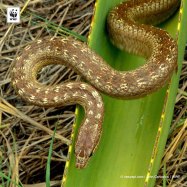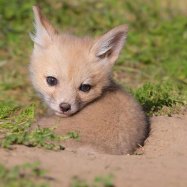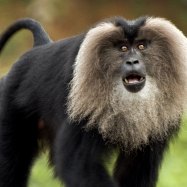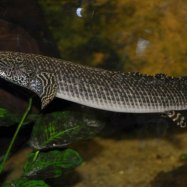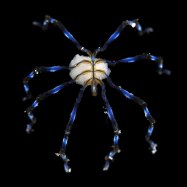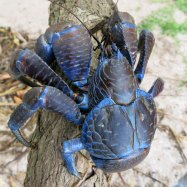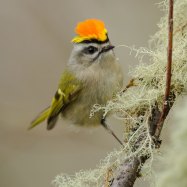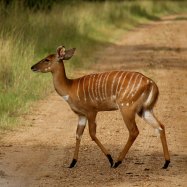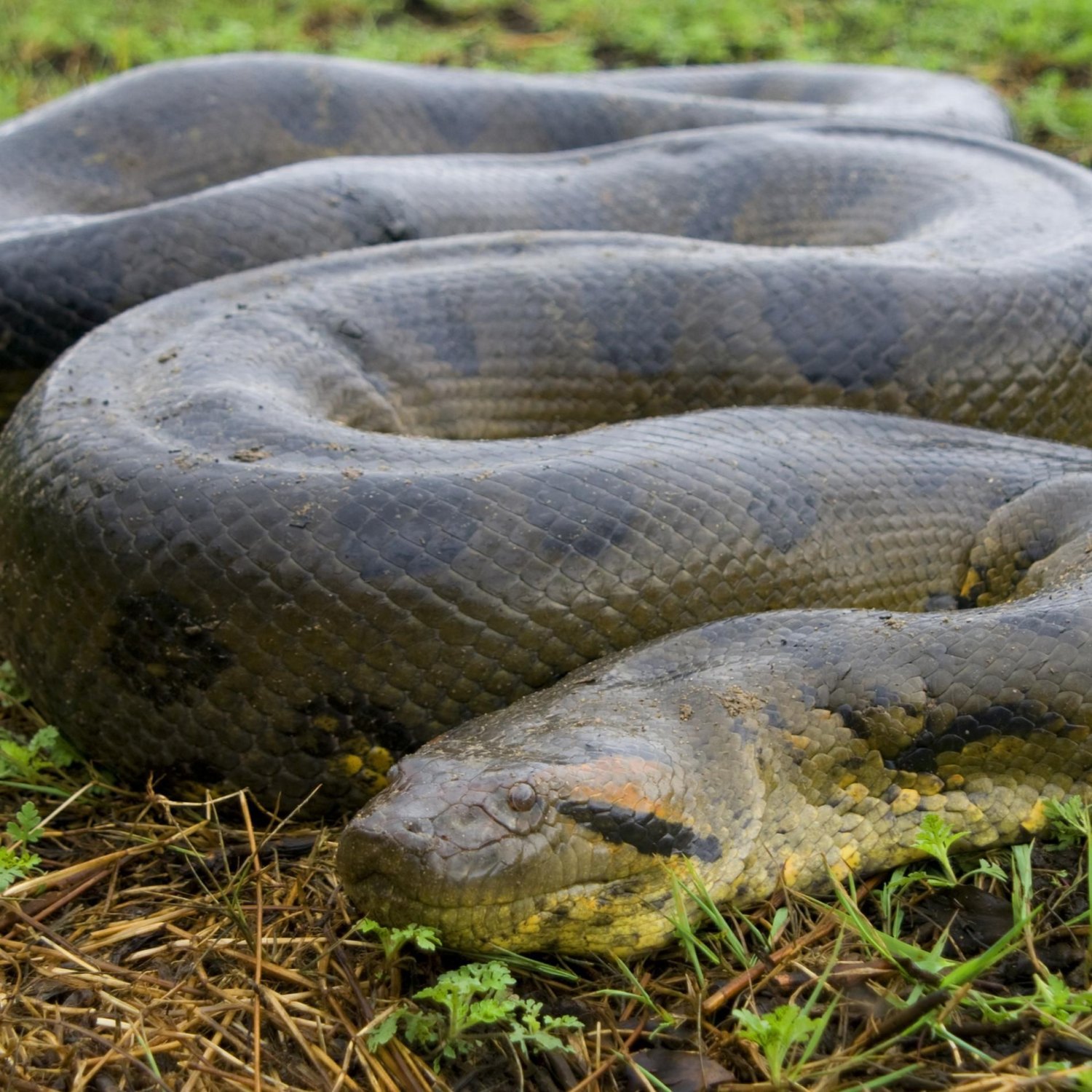
Anaconda
Up to 30 feet (9 meters)
Anacondas are one of the most iconic creatures of the Amazon rainforest. These giant snakes can grow up to 30 feet in length and belong to the family Boidae. Their cylindrical body shape helps them move swiftly through the water, making them expert swimmers. Despite their intimidating size, anacondas are known to be non-venomous and usually only pose a threat to small animals. If you ever visit the Amazon, keep an eye out for this incredible reptile.
Animal Details Summary:
Common Name: Anaconda
Kingdom: Animalia
Habitat: Freshwater
The Mighty Anaconda: The Top Predator of the Amazon Rainforest
The Amazon rainforest is a vibrant and awe-inspiring place, full of unique and diverse plant and animal species. But among the dense foliage and rushing waters lies a creature that strikes fear in the hearts of even the bravest explorers - the anaconda.Anacondas belong to the scientific genus Eunectes, with their common name derived from the Sinhala word "henakandaya," meaning "whip snake." They are found in the Animalia kingdom, Chordata phylum, and Reptilia class Anaconda. These massive and powerful creatures are part of the Squamata order and Boidae family, making them relatives of other well-known snakes like boas and pythons.
Anaconda Habitat and Distribution
The natural habitat of anacondas is freshwater, making the Amazon rainforest an ideal location for them to thrive. They are found mainly in the freshwater bodies of South America, particularly in countries like Brazil, Peru, and Colombia. The expansive Amazon River and its surrounding tributaries are the primary locations for anacondas, offering them an abundance of prey and shelter.Anacondas are also known to inhabit marshes, swamps, and slow-moving rivers and streams. They have even been spotted near human settlements, despite their elusive nature.
A Carnivorous Predator
Anacondas are apex predators, which means they are at the top of the food chain. As carnivores, they feed on a variety of prey, including fish, birds, rodents, and even other reptiles. They are opportunistic hunters, meaning they will consume whatever prey is readily available in their habitat Asp Caterpillar.One of the unique feeding behaviors of anacondas is their ability to constrict their prey. They strike quickly and wrap their muscular bodies around their prey, suffocating them with their powerful grip. This method of predation also allows them to consume prey much larger than their own size.
The Cylindrical Body of an Anaconda
The most striking physical feature of anacondas is their shape. Unlike most other snakes, they have a cylindrical body shape that allows them to move swiftly and easily through the water. Their powerful muscles and streamlined body make them efficient swimmers, enabling them to navigate through the dense vegetation of the rainforest.Anacondas also have a unique respiratory system, which allows them to stay underwater for extended periods. They have a specialized organ called a suprabranchial gland, which allows them to extract oxygen from the air as they swim underwater.
A Record-Breaking Length
When it comes to the size of these massive snakes, there is no exaggeration. Anacondas are one of the longest and heaviest snakes in the world, with some individuals reaching lengths of up to 30 feet (9 meters) and weighing over 550 pounds (250 kilograms). This makes them not only one of the largest snakes but also one of the heaviest reptiles in the world.The size of anacondas has long been a source of fascination and fear among humans. Many stories and myths surround these creatures, with some claiming they can swallow humans whole. However, the truth is that anacondas rarely pose a threat to humans. They are generally shy and non-aggressive and will only attack when provoked or threatened.
Olive Green with Black Spots
Anacondas have a distinct and striking pattern on their skin, making them easily identifiable. They have an olive-green base color with dark black spots running along their entire body. This unique coloration allows them to blend in with the dense foliage of their rainforest habitat, making them excellent ambush predators.The color and pattern of an anaconda's skin may also vary depending on its location. Those living in marshes and swamps may have a more brownish color, while those in the dense rainforest may exhibit more prominent black spots.
The Role of Anacondas in the Ecosystem
As apex predators, anacondas play a crucial role in maintaining the balance of the Amazon rainforest ecosystem. They control the populations of their prey, which prevents overgrazing and ensures the stability of the food chain. By preying on smaller animals, they also help regulate the spread of certain diseases, keeping the ecosystem healthy.Furthermore, anacondas also act as indicators of the overall health of their habitat. As air-breathing reptiles, they are sensitive to changes in water quality, temperature, and habitat degradation. Studying and monitoring anaconda populations can provide valuable insights into the overall health of the Amazon rainforest and its freshwater bodies.
Conservation of Anacondas in the Wild
Despite their crucial role in the ecosystem, anacondas are facing several threats in the wild. Habitat destruction and fragmentation due to human activities, such as deforestation and dam construction, have reduced their natural habitat.Anacondas are also at risk of being hunted for their skin and meat, although hunting them is illegal in most countries. The pet trade is also a significant threat, with some people keeping them as exotic pets, often without proper care or knowledge of their needs.
To protect anacondas and their habitat, conservation efforts are underway. Protected areas have been designated, and governments are implementing stricter laws and penalties for hunting and trafficking of these snakes. Education and awareness programs are also vital in promoting the conservation of these magnificent creatures and their environment.
Conclusion
With their massive size, unique appearance, and important role in the ecosystem, anacondas truly are one of the most fascinating creatures in the Amazon rainforest. Despite their fearsome reputation, they are not the man-eating monsters portrayed in movies and myths. Instead, they are an essential and magnificent species that should be respected and protected for future generations to appreciate.

Anaconda
Animal Details Anaconda - Scientific Name: Eunectes
- Category: Animals A
- Scientific Name: Eunectes
- Common Name: Anaconda
- Kingdom: Animalia
- Phylum: Chordata
- Class: Reptilia
- Order: Squamata
- Family: Boidae
- Habitat: Freshwater
- Feeding Method: Carnivorous
- Geographical Distribution: South America
- Country of Origin: Brazil
- Location: Amazon Rainforest
- Animal Coloration: Olive green with black spots
- Body Shape: Cylindrical
- Length: Up to 30 feet (9 meters)
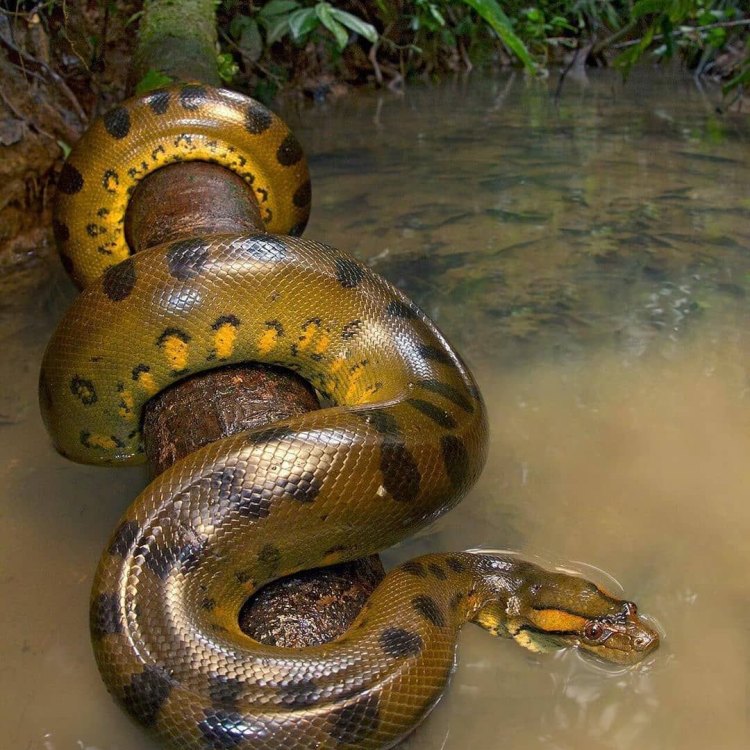
Anaconda
- Adult Size: Average length is around 20 feet (6 meters)
- Average Lifespan: Around 10 years in the wild
- Reproduction: Sexual
- Reproductive Behavior: Females give birth to live young
- Sound or Call: No specific sound or call
- Migration Pattern: Non-migratory
- Social Groups: Solitary
- Behavior: Mainly nocturnal and semi-aquatic
- Threats: Habitat loss and hunting
- Conservation Status: Not evaluated
- Impact on Ecosystem: Top predator in its habitat
- Human Use: Leather and meat trade
- Distinctive Features: Large size and ability to constrict prey
- Interesting Facts: Anacondas are one of the heaviest snakes in the world
- Predator: Humans are the primary predator
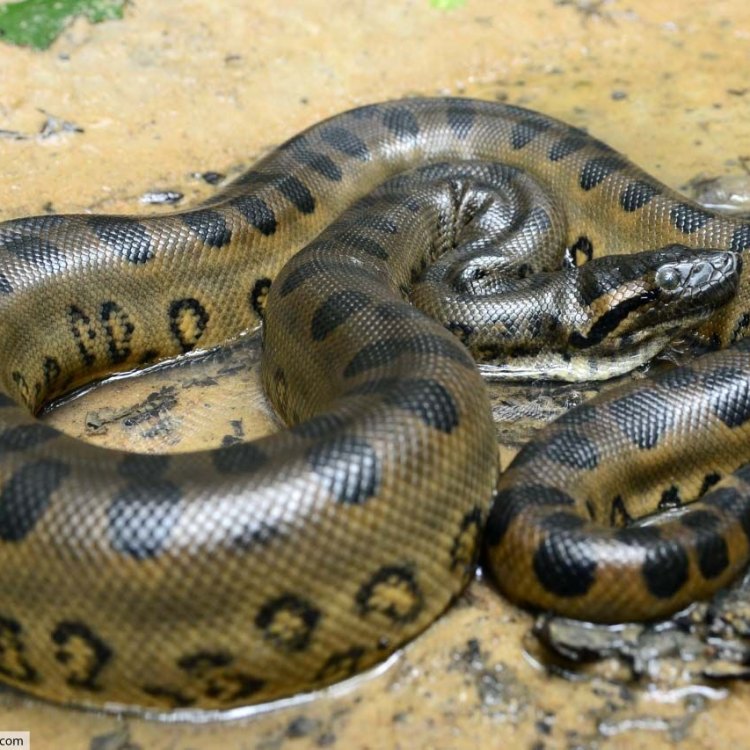
Eunectes
The Fascinating World of Anacondas: The Mighty and Mysterious Giants of the Amazon
The Amazon rainforest is home to an incredible variety of plants and animals, and among them, lurks a creature that has captured the imagination of adventurers and storytellers for centuries. We are talking about the world's largest snake, the anaconda. With its massive size, impressive abilities, and enigmatic behavior, the anaconda has become a symbol of the incredible diversity and power of the Amazon.So, let's dive deep into the fascinating world of anacondas and uncover some of their unique features and behaviors that make them one of the most captivating creatures of the rainforest PeaceOfAnimals.Com.
A Glimpse into the Life of an Anaconda
Adult anacondas can reach a length of around 20 feet (6 meters), making them one of the longest snakes in the world. These magnificent giants can weigh up to 550 pounds, making them one of the heaviest species of snake on the planet. These colossal creatures have an average lifespan of around 10 years in the wild, although some have been known to live up to 30 years in captivity.Anacondas are a type of constrictor snake, meaning they suffocate their prey by tightly wrapping their muscular bodies around them. They are also a non-venomous species, relying solely on their impressive size and strength to take down their prey. But more on that later.
Reproductive Behavior: Birth by Live Young
Anacondas are sexual reproducers, meaning they reproduce through internal fertilization. Male anacondas have two penises, called hemipenes, which they use to fertilize females. After mating, the female can hold the sperm inside her body for up to six months before fertilization occurs Albertonectes. This adaptation allows the female to choose the best time to fertilize her eggs, giving her offspring the best chance of survival.Unlike most snakes, female anacondas give birth to live young instead of laying eggs. This is known as ovoviviparity, where the eggs hatch inside the female's body, and the young are born fully formed. An average litter consists of 20-40 babies, making it one of the largest broods in the snake world.
A Solitary and Nocturnal Lifestyle
Anacondas are solitary creatures that prefer to live near water bodies like rivers, streams, and swamps. They are mainly nocturnal animals, meaning they are most active at night, making them challenging to spot in the wild. During the day, they can be found resting underwater or on the banks of a river, disguising themselves among the vegetation.These formidable predators are also semi-aquatic, meaning they can swim and spend extended periods underwater. With their eyes and nostrils positioned on the top of their heads, they can easily float in the water and scan for potential prey. This unique adaptation also helps them camouflage themselves from other predators.
Threats to the Mighty Anaconda
Despite being one of the top predators in their habitat, anacondas face several threats in the wild. Habitat loss, mainly due to human activities such as mining and deforestation, has forced these giant snakes out of their natural habitat. This loss of habitat has also led to a decline in their prey population, making it harder for them to find food.Another significant threat to anacondas is hunting. In some regions, these snakes are hunted for their skin, which is used to make leather products, and their meat, which is considered a delicacy in some cultures. Although hunting anacondas is illegal in many places, it continues to be a significant concern for their population.
The Impact of Anacondas on the Ecosystem
As top predators, anacondas play a vital role in maintaining the balance of their ecosystem. They help control the population of their prey, which includes smaller animals like rodents, fish, and birds. Without these giant predators, the population of smaller animals can grow out of control, leading to disastrous consequences for the ecosystem.In some cases, anacondas have been known to prey on larger animals like deer, caimans, and even jaguars. This proves how essential they are in regulating the population of their prey, which can impact all levels of the food chain.
The Human Use of Anacondas
Unfortunately, humans have also found a use for these magnificent creatures. In some parts of South America, anacondas are hunted for their skin, which is then exported to be used in the leather trade. Their meat is also considered a delicacy in some cultures, and it is hunted and sold in local markets.In addition to their use for trade and meat, anacondas are also bred in captivity for educational and research purposes. However, it is crucial to note that captive breeding is highly regulated, and it has not yet been proven to help conserve the species.
Distinctive Features: Large Size and Powerful Constriction
Of all the incredible features of anacondas, their sheer size and ability to constrict their prey are perhaps the most impressive. As mentioned earlier, these massive snakes can reach up to 20 feet in length and weigh over 500 pounds, capable of taking down even the largest of prey. Their muscular bodies and powerful coils enable them to squeeze their prey until it suffocates and eventually dies.Interestingly, anacondas have been known to eat prey much larger than themselves, and they can go weeks, even months, without eating after a large meal. This ability to eat infrequently is an adaptation for their environment, where food is scarce and unpredictable.
Interesting Facts: Mighty Anacondas and Their Mystical Tales
The fascinating world of anacondas has also given rise to many myths and legends. Some of the most famous tales include the belief that anacondas can swallow a person whole, and that their skin has magical properties. While these stories may seem far-fetched, they speak volumes about the awe and fear that these great snakes evoke in us.However, one interesting fact that is not a myth is that anacondas are excellent swimmers and can hold their breath for up to 10 minutes. This unique ability allows them to catch prey underwater and stay submerged for long periods, making them even more elusive to spot in their natural habitat.
The Ultimate Predator: Humans
Despite their size and impressive abilities, humans are the primary predators of anacondas. Apart from hunting them for their skin and meat, humans also pose a threat to these snakes through pollution and destruction of their habitat. This conflict between humans and anacondas highlights the importance of conservation efforts to protect these magnificent creatures and their vital role in the ecosystem.In Conclusion
In conclusion, the anaconda is an elusive and mysterious giant of the Amazon rainforest. With its impressive size, unique reproductive behaviors, and powerful abilities, this snake has captivated our imagination and instilled both fear and fascination in us. However, with their habitat at risk and humans being their primary predator, it is crucial to step up efforts to conserve these mighty creatures for generations to come.
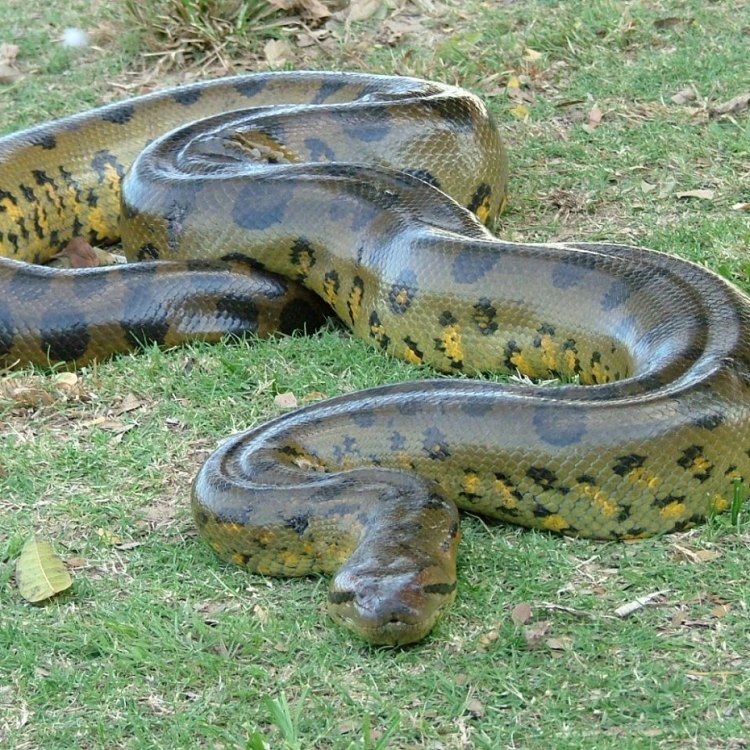
The Mighty Anaconda: The Top Predator of the Amazon Rainforest
Disclaimer: The content provided is for informational purposes only. We cannot guarantee the accuracy of the information on this page 100%. All information provided here may change without prior notice.


